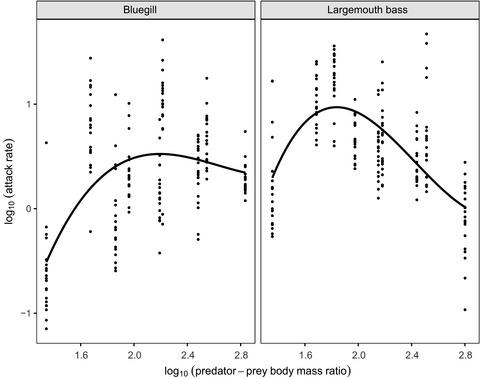当前位置:
X-MOL 学术
›
Ecol. Evol.
›
论文详情
Our official English website, www.x-mol.net, welcomes your
feedback! (Note: you will need to create a separate account there.)
Influence of intra- and interspecific variation in predator-prey body size ratios on trophic interaction strengths.
Ecology and Evolution ( IF 2.3 ) Pub Date : 2020-06-01 , DOI: 10.1002/ece3.6332 Ross N Cuthbert 1, 2, 3 , Ryan J Wasserman 3, 4 , Tatenda Dalu 3, 5 , Horst Kaiser 6 , Olaf L F Weyl 6, 7 , Jaimie T A Dick 2 , Arnaud Sentis 8 , Michael W McCoy 9 , Mhairi E Alexander 3, 10, 11
中文翻译:

捕食者-猎物体型比例的种内和种间变异对营养相互作用强度的影响。
更新日期:2020-06-26
Ecology and Evolution ( IF 2.3 ) Pub Date : 2020-06-01 , DOI: 10.1002/ece3.6332 Ross N Cuthbert 1, 2, 3 , Ryan J Wasserman 3, 4 , Tatenda Dalu 3, 5 , Horst Kaiser 6 , Olaf L F Weyl 6, 7 , Jaimie T A Dick 2 , Arnaud Sentis 8 , Michael W McCoy 9 , Mhairi E Alexander 3, 10, 11
Affiliation

|
- Predation is a pervasive force that structures food webs and directly influences ecosystem functioning. The relative body sizes of predators and prey may be an important determinant of interaction strengths. However, studies quantifying the combined influence of intra‐ and interspecific variation in predator–prey body size ratios are lacking.
- We use a comparative functional response approach to examine interaction strengths between three size classes of invasive bluegill and largemouth bass toward three scaled size classes of their tilapia prey. We then quantify the influence of intra‐ and interspecific predator–prey body mass ratios on the scaling of attack rates and handling times.
- Type II functional responses were displayed by both predators across all predator and prey size classes. Largemouth bass consumed more than bluegill at small and intermediate predator size classes, while large predators of both species were more similar. Small prey were most vulnerable overall; however, differential attack rates among prey were emergent across predator sizes. For both bluegill and largemouth bass, small predators exhibited higher attack rates toward small and intermediate prey sizes, while larger predators exhibited greater attack rates toward large prey. Conversely, handling times increased with prey size, with small bluegill exhibiting particularly low feeding rates toward medium–large prey types. Attack rates for both predators peaked unimodally at intermediate predator–prey body mass ratios, while handling times generally shortened across increasing body mass ratios.
- We thus demonstrate effects of body size ratios on predator–prey interaction strengths between key fish species, with attack rates and handling times dependent on the relative sizes of predator–prey participants.
- Considerations for intra‐ and interspecific body size ratio effects are critical for predicting the strengths of interactions within ecosystems and may drive differential ecological impacts among invasive species as size ratios shift.
中文翻译:

捕食者-猎物体型比例的种内和种间变异对营养相互作用强度的影响。
- 捕食是构建食物网并直接影响生态系统功能的普遍力量。捕食者和猎物的相对体型可能是相互作用强度的重要决定因素。然而,缺乏量化种内和种间变异对捕食者与猎物体型比例的综合影响的研究。
- 我们使用比较功能反应方法来检查入侵性翻车鱼和大口黑鲈的三个尺寸类别与其罗非鱼猎物的三个尺寸类别之间的相互作用强度。然后,我们量化了种内和种间捕食者与猎物的体重比对攻击率和处理时间的影响。
- 所有捕食者和猎物体型大小的捕食者均表现出 II 型功能反应。在小型和中型捕食者尺寸级别上,大口黑鲈的捕食量比翻车鱼多,而这两个物种的大型捕食者则更为相似。总体而言,小型猎物是最容易受到伤害的。然而,不同大小的捕食者之间的猎物攻击率存在差异。对于蓝鳃太阳鱼和大口黑鲈,小型捕食者对小型和中等尺寸的猎物表现出更高的攻击率,而较大的捕食者对大型猎物表现出更高的攻击率。相反,处理时间随着猎物大小的增加而增加,小翻车鱼对中大型猎物类型的摄食率特别低。两种捕食者的攻击率在捕食者与猎物体重比处于中等水平时均达到单峰峰值,而随着体重比的增加,处理时间通常会缩短。
- 因此,我们证明了体型比对关键鱼类之间捕食者-猎物相互作用强度的影响,攻击率和处理时间取决于捕食者-猎物参与者的相对大小。
- 考虑种内和种间体型比例效应对于预测生态系统内相互作用的强度至关重要,并且随着体型比例的变化,可能会导致入侵物种之间产生不同的生态影响。











































 京公网安备 11010802027423号
京公网安备 11010802027423号